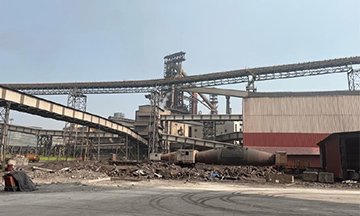Professor Vikram Gandhi’s Immersive Field Course (IFC) “Development while Decarbonizing: India’s Path to Net-Zero" delved into the critical aspect of decarbonization and sustainability goals amid India's rapid development. The course presented an opportunity for students to advance their knowledge of sustainability efforts, decarbonization, and net zero in the context of a broader development agenda. The class culminated in a series of site visits in January 2024 in Mumbai and Bangalore and this is one of 14 student essays that highlights their reflections on uncovering sustainable solutions across the country.
Our recent visit to JSW Cement was a fascinating peek into the world of circularity within hard-to-abate industries. Imagine towering cranes unloading shiploads of blast furnace slag, a by-product from neighboring JSW Steel, and transforming it into a key ingredient for durable, more sustainable cement. This wasn't your typical cement factory; it was a testament to how waste can become a valuable resource, and the future promise of circularity.

Unlike most cement plants, JSW Cement's story starts next door. Its location, strategically chosen, allows it to directly harness the waste products of steel production. Blast furnace slag becomes a substitute for clinker, the traditional backbone of cement. By incorporating this slag, JSW significantly reduces its consumption of clinker, typically imported from the UAE, and responsible for the majority of cement's carbon footprint.
Low-clinker cements are paving the way for a more sustainable future. These innovative materials significantly reduce clinker content, often by 50% or more, by incorporating alternative materials like blast furnace slag, fly ash, or geopolymers. This clever substitution slashes carbon emissions, some formulations boasting a 70% reduction compared to traditional cement. The benefits go beyond carbon reduction. Low-clinker cements often exhibit superior strength and durability, especially in harsh environments like coastal regions. Structures built with these cements can withstand saltwater erosion and extreme weather conditions better, leading to longer lifespans and reduced maintenance costs.
As typical with many green industrial products, low-clinker cements are currently slightly more expensive than their traditional counterparts (typically a ~20% premium). However, with advancements in production technologies, the cost gap is steadily narrowing. Additionally, their availability might be limited in certain regions, but as demand grows, production is expected to expand. JSW Cement's current capacity in India stands at 19 million tonnes per annum. Looking ahead, their medium-term target sets their sights even higher, aiming to reach 60 million tonnes capacity within the next four years. Initially, this slag-blended cement, with its lighter color, faced consumer skepticism. The team educated buyers about the superior strength and environmental benefits of the product, which paid off. Slag-blended cement is now in coastal regions where its enhanced durability against saltwater erosion shines.
JSW also recognizes the need for flexibility. Not all applications can utilize slag-blended cement. To cater to diverse customer requirements, they still maintain a small production line dedicated to traditional 100% clinker cement. This balanced approach ensures they can meet the needs of all their customers while steadily pushing towards sustainable cement production.

JSW's commitment to circularity goes beyond blast furnace slag as they additionally use other steelmaking by-products like alumina kiln slag and Linz-Donawitz (LD) slag. This pursuit of innovation not only diverts waste from landfills but also results in a more durable cement. Beyond cement production, JSW Cement is incorporating green technology into their entire supply chain and production processes. In September 2023, they embarked on a pioneering initiative: piloting electric vehicles (EV trucks) in their logistics operations. JSW Cement is one of the first movers in the cement industry to adopt EV trucks. The initial pilot project is five EV trucks integrated into their transportation network across manufacturing facilities in Andhra Pradesh and Karnataka. This shift in logistics is projected to yield substantial environmental benefits, estimated to avoid over 150 tonnes of carbon emissions annually – equivalent to the CO2 absorption power of 6,000 trees!
This combination of efforts is yielding promising results–JSW Cement boasts a remarkable carbon emission intensity of just 173 kg/tonne, a mere 30% of the global cement sector's average. This impressive achievement is further solidified by their top ranking in the Sustainalytics ESG risk rating for the construction materials industry group, encompassing over 140 companies.
Overall, our visit to JSW Cement was an exciting example of the circular economy in action. It showcased the power of collaboration, with steel and cement production efficiently co-located, creating a closed-loop system that minimizes waste and maximizes resource efficiency. JSW Cement serves as an inspiration, not just for the cement industry, but for all businesses seeking to embrace circularity and build a more sustainable future.
Key takeaways:
● JSW Cement strategically utilizes blast furnace slag from JSW Steel, reducing clinker usage and carbon footprint.
● They are actively exploring other steelmaking byproducts like alumina kiln slag and LD slag for further circularity.
● The slag-blended cement, initially met with resistance, has proven its strength and is now used in coastal regions.
● JSW maintains a balance between sustainability and customer needs, offering both clinker and slag-blended cement.
● JSW Cement's story is a testament to the power of innovation and collaboration in building a circular economy.

